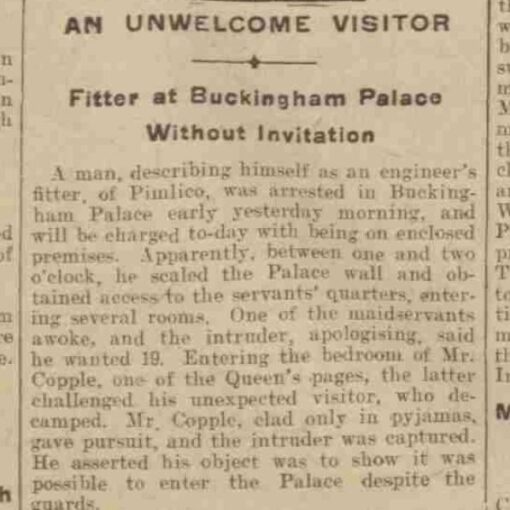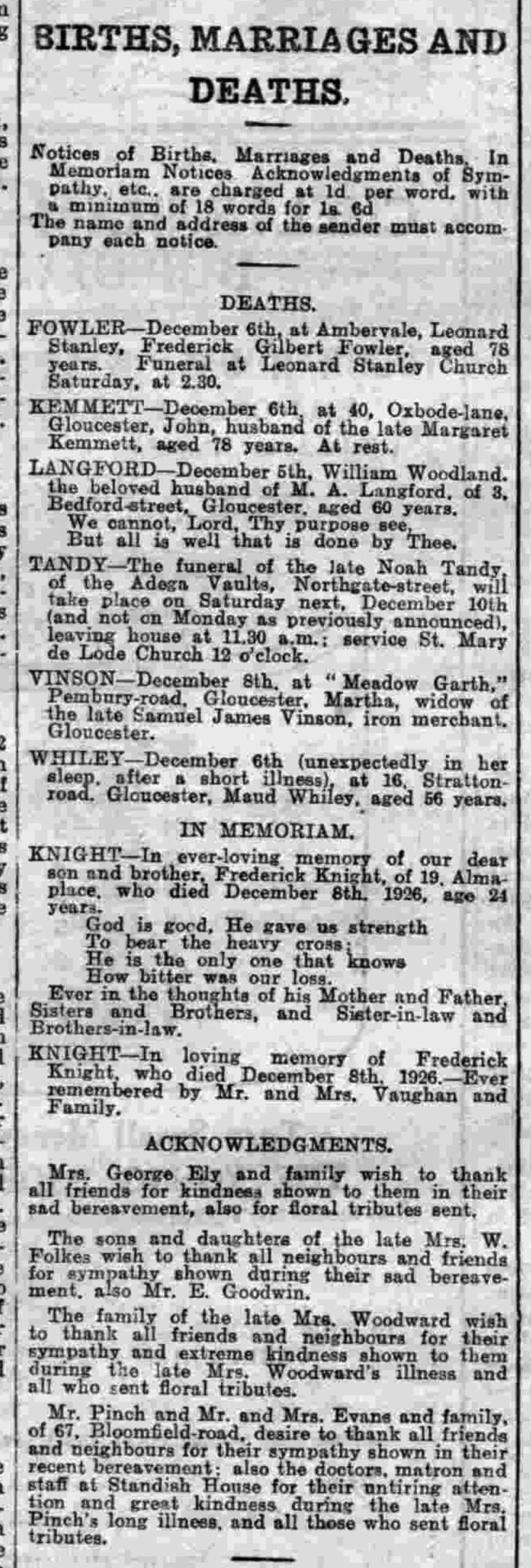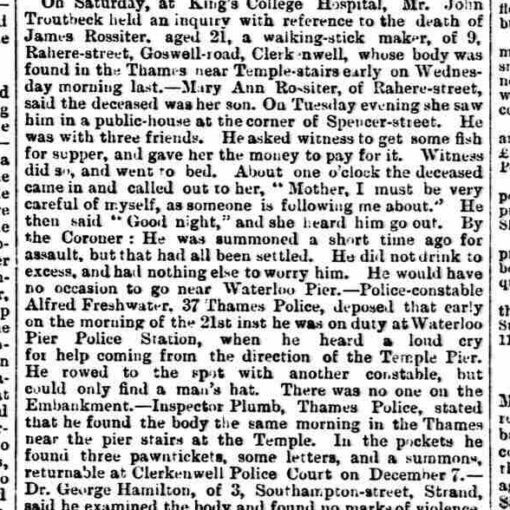FRIGHTFUL ACCIDENT ON THE NORTH KENT RAILWAY.
Also on this page:
The State of Rail Safety in the UK During the 1850s
Importance of Historical News Articles for Historians and Genealogists
Free to use British Newspaper Research Service
COLLISION OF TRAINS.

Wilts and Gloucestershire Standard – Saturday 04 July 1857
A frightful accident occurred a few minutes after eleven o’clock on Sunday night between the Blackheath and Lewisham stations of the North Kent Railway. It resulted in the death of eleven persons, while many others were so seriously injured as to render their recovery almost hopeless. The Sunday traffic on this line is very heavy, and for the accommodation of persons returning from Gravesend and other places of holiday resort, it is usual to run two late trains at short intervals — 8.15 p.m. and 9.30 p.m. — from Strood to London.
This line of railway is worked on Tyer’s electric signal system, the simple explanation of which is, that the station-master or clerk at one station must not allow one moving train to pass before the next station has been telegraphed cleared out of the expected train. This plan is properly carried out when it prevents the possibility of accident.
It appears that the 9.15 train from Strood left at the time appointed for departure, and passed Lewisham station without difficulty. The up mail train from Dover was not then due at that point, but on entering the Lewisham station, which is about a mile from the Blackheath tunnel, the home signal was seen at “danger,” and the driver pulled up. It appears that this was done while in the hollow part of the tunnel. The engine-driver sent his stoker forward to ascertain the cause of the danger signal, but in a few minutes he was horrified to see the reflection of the engine of another train approaching at the mouth of the tunnel. The driver, on seeing this, put on all steam, but before the train could be moved more than its own length a collision occurred of the most frightful character. The engine of the second train dashed with great violence into the rear of the first train, smashing it to pieces and rendering it a mass of ruins.
Several of the carriages were shattered into splinters, and the engine of the second train cut its way through the broken fragments of the last carriage, and buried itself between the broken timbers and ironwork. The passengers in this carriage suffered the most frightfully; those who escaped death were buried under the broken fragments and ironwork. The reports of the sufferers who escaped indicate that the crash was fearful; the whole place was instantly filled with the piercing cries and groans of the sufferers.
The driver and stoker, though much shaken, escaped serious injury, but Mr. Foord, the manager of the line, was soon on the spot, personally directing the exertions of a large number of labourers and others, who had been pressed into the service at the moment the accident occurred. The sufferings of some of the injured persons are described to have been most excruciating, until death put an end to their pain. One man, who is stated to have been nearly ripped in two, was pinned down by a mass of ironwork and broken wheels round the extremity of the spot, met his fearful end in silent agony; his sufferings were so prolonged that a full half-hour passed before he died.
The scene of the accident was frightful beyond description; and upon numbering the casualties, it was found there were eight dead bodies removed from the immediate ground of the accident; four persons were in extreme agony, and dangerously wounded not to be removed, yet laid about thirty others who were more seriously injured.
NAMES OF THE DEAD AND WOUNDED.
The following is an accurate list of those dead and missing, and of many of the wounded: John Lawless, Langley, Westwood, joiner; William Pugh, of Plaistow; Thomas Franklin, 16, Great-Marybone, Blackfriars-road; Mr. Broughton, surgeon, Brock-street, West; Mr. Solomon; Thomas Turner, foreman of the St. Giles’ City; William Nightingale, 7, Bream’s-buildings, Chancery-lane; Thomas Dalton, Aldersgate-street; Frances Franklin, servant, Shakespeare-place, Bermondsey.
At St. Thomas’s, upwards of thirty had their wounds dressed, and the rest were removed to other infirmaries, including Lewisham-hospital. Among the others were: Wm. Collins, 16, Cow-street, Finsbury, both legs fractured; Mr. Solomon, the husband of Mrs. Collins; Mr. Thomas, Wandsworth-road, fractured arm, ribs fractured, and otherwise severely injured; Geo. Wilson, City of London Rifles, internal injuries; a number of others also seriously hurt, including several ladies who had their legs and arms fractured, and other very severe injuries.
EXAMINATION OF THE DRIVER AND STOKER.
As soon as the dead and injured were removed from the line, Mr. Foord, with Mr. Knight, superintendent of the railway, proceeded to inquire into the cause of the accident, and after a careful investigation, Mr. Foord feels satisfied by the general direction of the signals that Mr. Edwards, the pointsman, is to blame, owing to his neglect of duty in not changing the signal at Lewisham station. The jury granted an adjournment of the inquest until Tuesday morning.
DIRECTORS’ STATEMENT.
The directors of the South-Eastern Railway Company have instituted an inquiry into the circumstances, and on Tuesday morning the engineer of the line attended the inquiry at the inquest room. He attributed the accident to mismanagement, and negligence on the part of the signalman and the driver of the train which caused the collision. The pointsman and railway officials, who admitted to having neglected their duties, have been suspended.
CORONER’S INQUIRY.
On Tuesday morning, C. J. Carttar, Esq., the coroner for West Kent, commenced his inquiry at the Phoenix Inn, Lewisham-bridge-road, before a jury. Mr. Robinson, clerk to the solicitor of the South-Eastern Railway Company, attended on behalf of the railway. Mr. Harvey, the manager of the North Kent line; Mr. Bond, surgeon; Mr. Solomon for the injured Mrs. Collins. The coroner gave a brief outline to the jury and proceeded to examine the bodies. Evidence was then received for identification. Further inquiries are set to continue, with the hearing adjourned until Friday.
The State of Rail Safety in the UK During the 1850s
The 1850s marked a pivotal yet perilous era in the development of the railway system in the United Kingdom. By this period, the UK had become the first country in the world to establish a comprehensive railway network, with a vast web of tracks connecting cities, towns, and industrial hubs. However, this period was also rife with risks and dangerous conditions that highlight the growing pains of a rapidly expanding industry. Despite being hailed as a technological marvel, the railways of the 1850s had a disconcerting record of safety, primarily due to rapid expansion, inadequate regulation, and the prioritisation of profit over passenger welfare.
1. Rapid Expansion and its Consequences
The UK railway network witnessed unprecedented growth in the 1840s and 1850s, known as the “Railway Mania” era. Investors were pouring substantial sums into railway companies, leading to a frenzy of construction projects. By 1850, there were thousands of miles of railway lines crisscrossing the country, facilitating faster travel and a booming freight industry.
However, the speed of expansion came at a cost. Many railway companies prioritised extending their networks over ensuring the safety and reliability of existing tracks. Newly constructed lines were often built hastily with little regard for engineering standards, leading to structural weaknesses. This resulted in poorly designed stations, insufficient signalling systems, and the use of substandard materials, all of which posed significant risks to passengers and railway employees.
2. Dangers of Rail Travel in the 1850s
The dangers associated with rail travel in the 1850s were numerous and stemmed from both technical and operational flaws:
- Inadequate Signalling Systems: One of the major causes of accidents was the lack of a standardised and reliable signalling system. The article you shared mentions the use of “Tyer’s electric signal system,” which was intended to prevent collisions by ensuring that station-masters did not allow a train to proceed until the line was clear. However, even this early signalling technology was prone to human error and mechanical failures. Many lines relied on primitive semaphore signals or hand signals, which were not always visible or understood by train drivers, leading to frequent miscommunications.
- Mechanical Failures: The steam engines of the 1850s were complex and often unreliable machines. Boiler explosions, wheel failures, and brake malfunctions were all common mechanical issues that could lead to catastrophic accidents. The maintenance of locomotives was frequently substandard, and regular inspections were not mandated across the industry.
- Overcrowded and Fragile Carriages: Rail companies often maximised profits by cramming as many passengers as possible into carriages, which were usually built from wood. In the event of a collision or derailment, these flimsy wooden carriages would splinter, causing severe injuries or death to passengers. Additionally, there were no standardised designs for carriages, and many lacked safety features such as strong couplings or secure doors.
- Poor Working Conditions for Railway Staff: The employees of the railways, including engine drivers, stokers, and signalmen, were often overworked and poorly trained. Long shifts with little rest increased the likelihood of human error. Many signalmen operated under immense pressure without adequate communication tools, which contributed to accidents like the one described in the article.
3. Accident Numbers and Notable Incidents
The 1850s were notorious for a high incidence of rail accidents. While comprehensive statistics are difficult to ascertain due to inconsistent record-keeping, contemporary reports and news articles reveal a grim picture:
- Frequent Collisions: Collisions were one of the most common types of accidents. These often occurred when two trains were allowed onto the same track or when a stationary train was struck from behind by another due to poor signalling.
- Derailments: Derailments were also prevalent, often caused by poor track conditions or defects in the train’s wheels. Track maintenance was frequently neglected, as companies focused their resources on expanding their networks rather than repairing existing lines.
- Boiler Explosions: Explosions of steam engines were another common hazard, caused by faulty boilers or poor handling by inexperienced drivers. These incidents were often fatal for both the train crew and passengers.
The notorious Clayton Tunnel crash of 1861, although occurring slightly later, is emblematic of the safety issues prevalent in the 1850s. It involved a signalling failure that resulted in a collision inside a tunnel, killing 23 people and injuring many more. This tragedy highlighted the inadequacies of the signal systems of the time, which had already caused numerous accidents throughout the 1850s.
4. Profit Over People: The Priorities of Railway Companies
During the 1850s, railway companies were primarily driven by the pursuit of profit, often at the expense of safety. The fierce competition among companies to establish routes and capture market share led to a culture of cost-cutting and risk-taking. Several factors illustrate this mindset:
- Minimal Investment in Safety: Despite the evident dangers, many railway companies invested little in safety improvements. Innovations such as the block system (which provided safer separation between trains) and continuous brakes (which could have prevented many collisions) were either ignored or implemented only after major accidents drew public outcry.
- Lack of Regulation and Oversight: At the time, the railway industry was largely self-regulated, with minimal government intervention. Companies had little external incentive to implement rigorous safety measures. It wasn’t until the Railway Inspectorate was strengthened in the late 19th century that stricter regulations were enforced.
- Maximising Passenger Numbers: The focus on profits led to overloading carriages beyond safe capacity, as described in many contemporary reports. Companies often advertised quick, cheap travel without considering the strain this placed on both the rolling stock and the infrastructure.
5.
Importance of Historical News Articles for Historians and Genealogists
Old newspaper articles, such as the one transcribed, are invaluable sources for historians and genealogists alike. They offer detailed, contemporaneous accounts of incidents that provide insights into the social, economic, and technological conditions of the time.
- Historical Context and Public Reaction: Articles like these help historians understand the development of the railway industry, public sentiment towards railway safety, and the pressures faced by railway companies. They also illustrate the limitations of early railway technology and the dire consequences of inadequate safety protocols.
- Personal Details and Genealogical Value: For genealogists, old news articles can be a treasure trove of information. They often include names, addresses, and occupations of victims, offering a glimpse into the lives of ordinary people who might otherwise be absent from historical records. In the case of the article you provided, it lists the names of the deceased and injured, potentially aiding descendants in tracing their ancestors.
- Insight into Early Journalism: The detailed narrative style of Victorian newspapers offers insight into the era’s journalistic practices, which favoured dramatic and emotive language to captivate readers. The vivid descriptions of accidents also reflect the public’s fascination and fear of the new railway technology.
Conclusion
The railways of the 1850s were both a symbol of progress and a source of peril. The rapid expansion and the prioritisation of profit over passenger safety led to a significant number of accidents, many of which were preventable with better regulation and technological advancements. Historical articles play a crucial role in shedding light on these incidents, helping us understand the challenges faced by early rail travellers and the evolution of railway safety. They also serve as poignant reminders of the human cost of industrial progress, preserving the stories of individuals who might otherwise have been forgotten.
Free to use British Newspaper Research Service
I search historical articles to locate mentions of your ancestors—whether they were involved in notable events or simply part of the everyday life reported in these newspapers. If relevant articles are found, I deliver them to you in a PDF format at no cost.
If I find articles, they’ll be sent to you in a clear, organized PDF. If not, you’ll be informed right away. See here.




